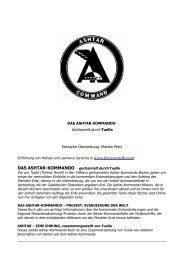ALIEN INTERVIEW - THE NEW EARTH - Earth Changes and The ...
ALIEN INTERVIEW - THE NEW EARTH - Earth Changes and The ...
ALIEN INTERVIEW - THE NEW EARTH - Earth Changes and The ...
Create successful ePaper yourself
Turn your PDF publications into a flip-book with our unique Google optimized e-Paper software.
Although the first integrated circuit was pretty crude <strong>and</strong> had some problems, the idea was<br />
groundbreaking. By making all the parts out of the same block of material <strong>and</strong> adding the<br />
metal needed to connect them as a layer on top of it, there was no more need for individual<br />
discrete components. No more wires <strong>and</strong> components had to be assembled manually. <strong>The</strong><br />
circuits could be made smaller <strong>and</strong> the manufacturing process could be automated.<br />
Jack Kilby (Texas Instruments) is probably most famous for his invention of the integrated<br />
circuit, for which he received the Nobel Prize in Physics in the year 2000. After his success<br />
with the integrated circuit Kilby stayed with Texas Instruments <strong>and</strong>, among other things, he<br />
led the team that invented the h<strong>and</strong>-held calculator.<br />
Jack Kilby now holds patents on over sixty inventions <strong>and</strong> is also well known as the inventor<br />
of the portable calculator (1967). In 1970 he was awarded the National Medal of Science.<br />
Robert Noyce, with sixteen patents to his name, founded Intel, the company responsible for<br />
the invention of the microprocessor, in 1968. But for both men the invention of the integrated<br />
circuit st<strong>and</strong>s historically as one of the most important innovations of mankind. Almost all<br />
modern products use chip technology.<br />
-- Reference: Wikipedia.org<br />
223 "...wiring is used for light, sub-light <strong>and</strong> ultra-light spectrum detection <strong>and</strong> vision."<br />
An optical fiber is a glass or plastic fiber designed to guide light along its length. Fiber<br />
optics is the overlap of applied science <strong>and</strong> engineering concerned with the design <strong>and</strong><br />
application of optical fibers. Optical fibers are widely used in fiber-optic communication,<br />
which permits transmission over longer distances <strong>and</strong> at higher data rates than other forms<br />
of communications. Fibers are used instead of metal wires because signals travel along<br />
them with less loss, <strong>and</strong> they are immune to electromagnetic interference. Optical fibers are<br />
also used to form sensors, <strong>and</strong> in a variety of other applications.<br />
In 1952, physicist Narinder Singh Kapany conducted experiments that led to the invention of<br />
optical fiber, based on Tyndall's earlier studies; modern optical fibers, where the glass fiber<br />
is coated with a transparent cladding to offer a more suitable refractive index, appeared later<br />
in the decade.<br />
In 1991, the emerging field of photonic crystals led to the development of photonic crystal<br />
fiber (Science (2003), vol 299, page 358), which guides light by means of diffraction from a<br />
periodic structure, rather than total internal reflection. <strong>The</strong> first photonic crystal fibers<br />
became commercially available in 1996. Photonic crystal fibers can be designed to carry<br />
higher power than conventional fiber, <strong>and</strong> their wavelength dependent properties can be<br />
manipulated to improve their performance in certain applications."<br />
-- Reference: Wikipedia.org<br />
224 "... fabrics of the interior of the craft..."<br />
"Technical textiles is the term given to textile products manufactured for non aesthetic<br />
purposes, where function is the primary criterion. This is a large <strong>and</strong> growing sector <strong>and</strong><br />
supports a vast array of other industries.<br />
It has been heard that soon textiles will be merged with electronics in all areas. In future<br />
wearable computers would be launched, these will not be like advance wrist watches etc,<br />
306





